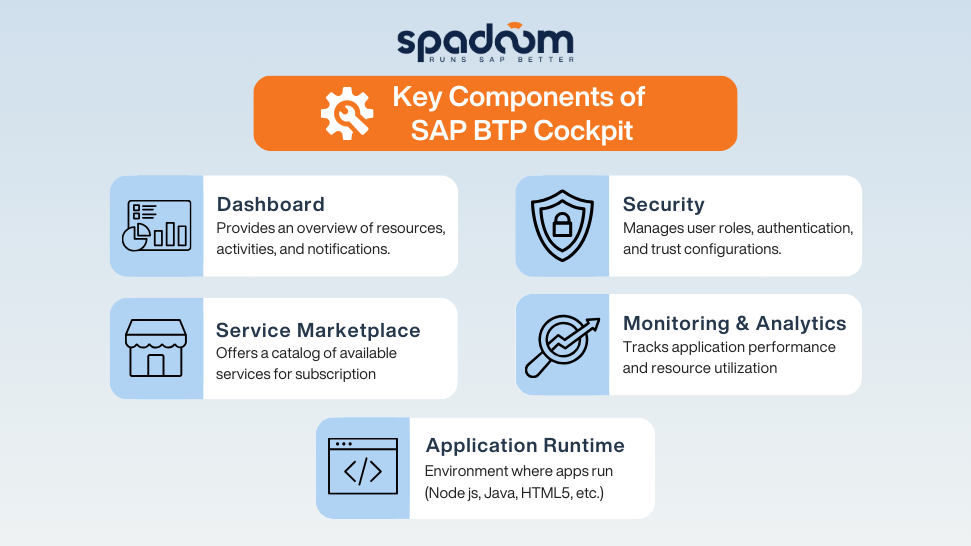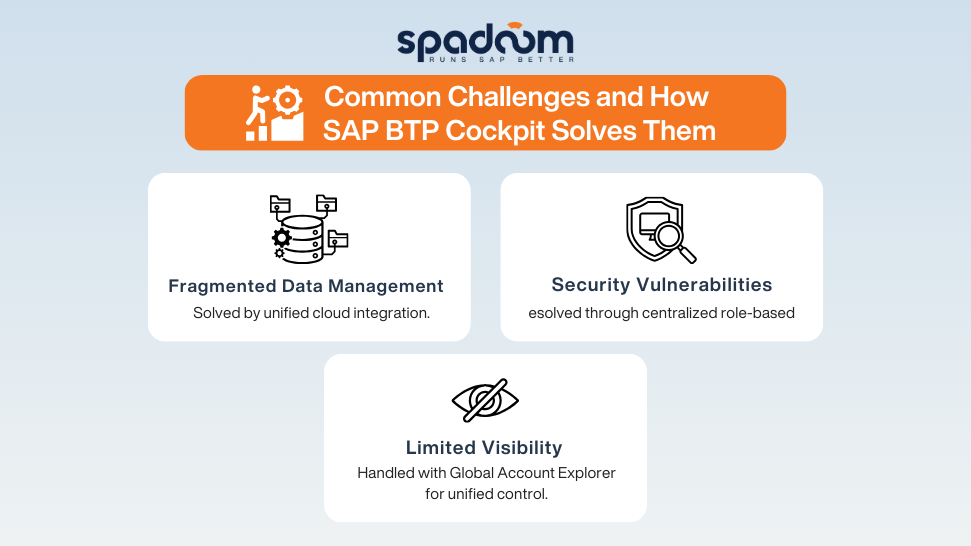Managing complex business technology can feel overwhelming, especially when juggling multiple applications, services, and data streams. That’s where SAP BTP Cockpit comes in, acting as a centralized hub for managing the SAP Business Technology Platform (BTP).
From resource allocation to security management, this centralized hub simplifies complex processes, making it easier for businesses to streamline their operations and maintain control over their technology stack. For companies engaged in SAP development, it offers a seamless way to oversee projects, optimize performance, and scale with confidence.
This is particularly vital in regions like Switzerland, where the tech sector is booming. Switzerland has emerged as a prime destination for innovative software solutions, driven by its growing pool of developers and software enterprises. As of May 2025, the country hosts over 2,000 SaaS startups, with the software development market expected to hit $15.2 billion by 2030, highlighting the immense potential for businesses leveraging BTP solutions.
In the upcoming sections, we’ll walk you through key aspects of SAP BTP Cockpit—from its core features and practical applications to best practices that help businesses stay efficient and agile.
What is SAP BTP Cockpit?
At its core, SAP BTP Cockpit is a web-based interface designed to simplify the management of SAP BTP accounts, services, and applications. Acting as a centralized control panel, it provides administrators and developers with the ability to efficiently oversee resources, configure security settings, and deploy applications across various environments.
Through its intuitive dashboard, users can view real-time insights, monitor service health, and manage application lifecycles—all from a single, streamlined platform.
Core Capabilities of SAP BTP Cockpit
One of the standout features of the BTP Cockpit is its robust resource management capabilities, allowing businesses to scale resources based on demand without disrupting operations.
This flexibility is crucial for SAP development projects that require dynamic allocation of processing power and database storage.
Accessibility is another key advantage of the BTP Cockpit. Users can log in through specific regional URLs, ensuring they connect to the nearest data centers for optimal performance and reduced latency.
Whether managing projects in Europe, North America, or Asia, the cockpit adapts seamlessly to local infrastructures, providing smooth and consistent access.
With its robust functionality and flexible access, SAP BTP Cockpit remains a key asset for modern enterprises looking to streamline their tech operations.
What Are the Key Components of SAP BTP Cockpit?

The SAP BTP Cockpit is designed with a set of powerful components that make business tech management seamless and efficient. At the forefront is the Dashboard, which provides a real-time overview of resources, activities, and critical notifications. This centralized display helps administrators keep track of active projects, monitor system health, and swiftly identify any anomalies that require attention.
Next is the Security Management module, where user roles, authentication, and trust configurations are handled. This component ensures that only authorized individuals have access to sensitive data, making it a crucial aspect of SAP development projects where security and compliance are non-negotiable. Administrators can effortlessly assign roles, configure permissions, and enforce strict security policies directly from the cockpit.
The Service Marketplace serves as a hub for discovering and subscribing to SAP services and third-party applications. This catalog makes it easy to scale solutions as business needs evolve, allowing companies to quickly integrate new functionalities without heavy manual configurations.
When it comes to Monitoring & Analytics, the cockpit excels in providing real-time insights into application performance and resource utilization. Businesses can easily track metrics, identify performance bottlenecks, and optimize processes for maximum efficiency.
Finally, the Application Runtime environment supports multiple development frameworks, including Node.js, Java, and HTML5, enabling smooth execution of applications directly within the platform. These core components collectively simplify resource management, boost security, and enhance scalability for modern enterprises.
Understanding the SAP BTP Cockpit Interface
The SAP BTP Cockpit Interface brings together the tools and views needed for efficient management of global accounts and subaccounts.
Here’s a closer look at how to access the cockpit, understand its layout, and make the most of its core functionalities.
Accessing the Cockpit
To get started, accessing the SAP BTP Cockpit requires logging in through a designated regional URL. This initial SAP BTP login step ensures optimal connectivity and directs you to the Global Account Selection page.
For example, if you are managing projects in Europe, you would access the cockpit through the specific Europe region URL. Upon login, you will be presented with the Global Account Selection page, where you can choose the global account you wish to manage.
It’s important to note that only users assigned to SAP BTP global accounts will see this selection. This initial screen is designed primarily for administrators and platform users, providing a straightforward interface to pick the right account and start managing resources.
Understanding the Layout
The SAP BTP Cockpit interface is structured for clarity and functionality. Upon entering the global account, you are greeted with the Account Explorer view. This section displays all directories and subaccounts associated with your global account.
Administrators can easily navigate through these directories and even create, delete, or modify subaccounts directly from this interface.
The left-hand sidebar is segmented into different functional areas:
- Entitlements: Manage the allocation of services and features to different subaccounts.
- Security and Usage Analytics: Monitor metrics and consumption rates of your configured capabilities.
- Service Marketplace: Access a wide array of SAP and third-party services, available for subscription and integration.
- Monitoring and Management: Oversee system health, application performance, and usage statistics in real-time.
When you click on a specific subaccount, the view updates to reveal more granular details. This includes region settings, provider information, domain specifics, tenant ID, and subaccount ID, enabling administrators to manage configurations with precision.
Getting Started with SAP BTP Cockpit
If you’re just stepping into the world of BTP Cockpit, it can feel a bit complex at first. To help you get familiar with its structure and features, we’ve compiled some useful resources to guide you through:
Official SAP BTP Cockpit Introduction Article
This article serves as an introduction to the main features of SAP BTP Cockpit. It explains the essentials of accessing your global account, setting up subaccounts, and managing key resources.
Included within the article is a demo video that visually guides you through the core steps, making it easier to understand how different components are linked and managed. This can be particularly beneficial as part of your SAP BTP training.
Expert Walkthrough with Riley Rainey
For a more in-depth look, check out this expert-led walkthrough by Riley Rainey on the SAP Community YouTube Channel. He explores the cockpit’s layout, features, and real-world applications, providing insights that go beyond the basics. This detailed session is an excellent resource if you’re looking to advance your SAP BTP training.
These resources have been handpicked to give you a solid foundation in managing your business tech using BTP Cockpit. Take advantage of these learning tools to familiarize yourself with its key components and interface before diving deeper into advanced features.
Best Practices for Optimizing SAP BTP Cockpit Usage
To make the most of the SAP BTP Cockpit, it’s essential to implement strategies that enhance efficiency and reduce risks.
Here are some best practices to keep your system running smoothly and cost-effectively:
Regular Monitoring
Setting up automated alerts for resource usage spikes is crucial for maintaining system stability. SAP BTP Cockpit allows you to configure notifications for critical metrics, helping you stay ahead of potential performance issues.
By actively monitoring these alerts, you can respond promptly, minimizing disruptions and keeping your projects on track.
Cost Management
Managing expenses effectively within SAP BTP Cockpit can significantly reduce financial strain. One useful feature is the “Costs and Usage” dashboard, which offers real-time visibility into credit usage.
Organizations can filter costs by subaccount or service and easily flag any service whose expenses have risen significantly, let’s say a service whose cost increased 20% from the last month, allowing for proactive adjustments before costs spiral out of control. This targeted approach helps prevent unexpected budget overruns and keeps financial planning on track.
To further optimize spending, leverage cost-tracking tools and regularly evaluate resource allocation. Involving SAP Service Partners can also streamline this process, as they offer specialized insights into financial management within SAP environments.
Backup and Recovery Plans
To safeguard data during upgrades or migrations, it’s essential to establish comprehensive backup and recovery strategies.
Regularly backing up critical configurations and maintaining version history helps prevent data loss, even in the event of unexpected system changes.
Performance Optimization
Efficient performance is key to maximizing the value of SAP BTP Cockpit. Implement techniques to reduce load times, such as optimizing database queries and clearing redundant data. Routine performance assessments help maintain responsiveness and ensure smooth operation.
Consulting with SAP Service Partners, like Spadoom, can further enhance your optimization efforts. We at Spadoom specialize in helping businesses fine-tune their SAP environments, making them more agile and cost-efficient.
Adopting these best practices not only improves your system’s efficiency but also helps you leverage the full potential of SAP BTP Cockpit for long-term success.
Common Challenges and How SAP BTP Cockpit Solves Them

SAP BTP Cockpit is designed to address some of the most common challenges faced in business technology management. Here’s how it effectively solves these issues:
Fragmented Data Management
One of the primary challenges businesses face is managing scattered data across different cloud environments. This fragmentation can lead to inefficiencies and gaps in visibility. SAP BTP Cockpit resolves this with its unified cloud integration, bringing all data points under a single dashboard for streamlined oversight.
Its Usage Analytics updates data every 24 hours, providing detailed insights per subaccount, service, and space. This real-time synchronization unifies fragmented data views, allowing decision-makers to monitor costs and optimize resources more effectively.
Security Vulnerabilities
Maintaining security across various applications and services is another significant hurdle. With SAP BTP Cockpit’s centralized role-based access, administrators can manage permissions from a single interface.
This prevents unauthorized access and ensures that only verified users can interact with critical business applications.
Limited Visibility Across Multiple Subaccounts
Managing multiple subaccounts across different regions often results in fragmented oversight. The Global Account Explorer in SAP BTP Cockpit solves this by providing a consolidated view of all subaccounts, security configurations, and service instances.
This centralized interface allows administrators to switch seamlessly between subaccounts, track resource usage, and enforce security policies consistently.
These targeted solutions make SAP BTP Cockpit a powerful tool for overcoming common business technology challenges, enhancing efficiency, security, and visibility.
Seamless SAP BTP Management with Spadoom
When it comes to managing and optimizing your SAP BTP environment, having the right partner makes all the difference. At Spadoom, we specialize in helping businesses make the most of SAP BTP Cockpit, from efficient resource management to seamless integration and enhanced security.
With our tailored approach, we ensure your SAP landscape aligns with your unique business needs, whether you’re looking to streamline operations, boost performance, or gain clearer insights into your tech environment. Our expert team provides comprehensive SAP consulting in Switzerland, guiding you through every step of your BTP journey.
By partnering with Spadoom, you gain access to dedicated support, practical solutions, and a strategic approach to business technology management. We don’t just deploy SAP BTP Cockpit, we tailor it to fuel your business growth, enhance efficiency, and maximize your technology investments.
Contact us today to discover how Spadoom can simplify your SAP BTP management and help your business thrive.
Frequently Asked Questions (FAQs)
What can I do in the SAP BTP Cockpit?
In the SAP BTP Cockpit, you can easily manage your cloud environment, including creating and organizing subaccounts and spaces. It also lets you assign roles and permissions, activate key services like Integration Suite and Workflow Services, and monitor your resource usage and costs.
How is SAP BTP Cockpit different from the BTP CLI?
The SAP BTP Cockpit provides a web-based interface for managing SAP BTP resources through interactive menus and dashboards. On the other hand, the BTP CLI allows you to perform these management tasks using command-line instructions, which can be more efficient for automation and scripting.
What environments and services can I manage in SAP BTP Cockpit?
In the SAP BTP Cockpit, you can manage different environments like Cloud Foundry, ABAP, and Kyma. Through the Service Marketplace, you can easily enable, configure, and monitor both SAP services and third-party applications, giving you full control over your cloud resources.
How does SAP BTP Cockpit support security and user management?
The SAP BTP Cockpit uses role-based access control (RBAC) to manage user permissions, ensuring that only authorized users have access to specific resources. It also supports single sign-on (SSO) through identity provider integration, making it easier to manage user access securely.
Can I manage multiple subaccounts and regions from the Cockpit?
Yes, with the Global Account Explorer in SAP BTP Cockpit, you can easily switch between multiple subaccounts and regions. It provides a unified view of all your resources, security configurations, and service instances, making it simple to manage everything in one place.



